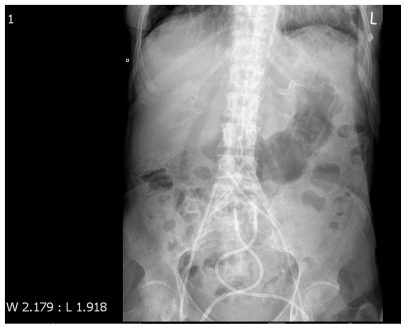Dialysis access remains the “Achilles heel” of maintenance hemodialysis. When candidate vessels have been exhausted in pursuit of fashioning native vascular access, alternative vessels are used. With recurrent catheter deployment, venous stenoses develop and render candidate veins unsuitable for catheter reception. We present a neat and novel solution for clinical practice in dealing with unexpected cases.
A 68-year-old female, with end-stage renal disease secondary to diabetic nephropathy had been receiving hemodialysis for 4 years. Her past medical history comprised: peripheral arterial disease with resultant bilateral above the knee amputation and iliac artery endovascular stenting; essential hypertension; lifelong tobacco consumption. She had no candidate vessels for venous catheter placement, other than small caliber femoral veins.
A decision was made to insert two smaller, more flexible 10 French catheters into bilateral femoral veins to allow better venous reception and more secure tunneling. This takes into account our experience with the use of larger, less supple catheters and the acute angles involved with typically tunneling upwards through the lower abdominal fascia. The patient was keen to continue dialysis and accepted the enhanced risk (two tunnels) of bilateral lower limb venous thrombosis and bacteremia. We present this interesting image (abdominal X-ray), demonstrating bilateral cuffed tunneled femoral dialysis access; concurrent vascular ectopic calcification and the presence of a left iliac stent. We understand this to be, the first medical image in the world literature of bilateral cuffed femoral dialysis catheters in situ – an unlikely clinical situation.
Disclosure
The authors report no conflicts of interest in this work.
